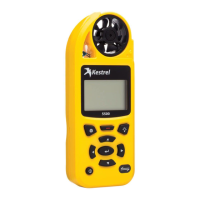17
16
type. Adjust the Set High and Set Low values to
bound the desired display values.
EXPORTING DATA LOGS TO A MOBILE DEVICE:
» Follow the links at www.kestrelinstruments.com
to locate Kestrel LiNK in the App or Play store and
install on your mobile device.
» Follow the directions in the Kestrel LiNK app and
in the section of this manual titled Pairing with a
Computer, Mobile Phone or Tablet: to connect the
mobile device to the Kestrel.
» The Kestrel’s new logged data will automatically be
added to the app’s log whenever the devices are
connected.
» To export logged data to a .csv le for further
analysis, go to the Stats page of the app or the
Manage Data Logs screen on the Manage page.
» Hit the Export Data button. Choose a method for
exporting the data and follow the in-app prompts
to send.
EXPORTING DATA LOGS TO A COMPUTER:
» Follow the links at www.kestrelinstruments.com
to download Kestrel LiNK to a PC or Mac computer.
Install.
Use one of the following two methods to connect
your Kestrel to your computer.
1. Connect your LiNK-enabled Kestrel Meter to
your computer wirelessly:
» Purchase a Kestrel LiNK Dongle and install in
your computer’s USB port.
» Follow the instructions in the “Pairing with a
Computer, Mobile Phone or Tablet” section of this
manual along with the Kestrel LiNK program to pair
the Kestrel and your computer.
2. Connect your Kestrel 5 Series Meter to your
computer using a Kestrel USB Data Transfer Cable:
» Purchase a Kestrel USB Data Transfer Cable.
» In the main Options menu, scroll to and select Data
Port and set to On.
» Insert the USB Data Transfer Cable into an open USB
port and the Data Transfer Port on the back of the
Kestrel unit.
Once connected
» Follow the directions in the Kestrel LiNK program to
conrm the connection.
» In the Kestrel LiNK software, choose a data log from the
Logs window and click on the Export to File button.
» Choose a le export directory on your computer and
click on the Ok button.
DIRECTION – Compass heading in true or magnetic
WIND SPD – Wind Speed is the measurement of the wind
passing through the impeller. For greatest accuracy, point the
back of the Kestrel directly into the wind.
CROSWND – Crosswind uses the internal compass and a user
selected heading to calculate the crosswind component of
the full wind.
HEADWND – Headwind uses the internal compass and a
user selected heading or target direction to calculate the
headwind component of the full wind.
TEMP – Ambient Temperature is the temperature measured
at the thermistor. For best results, ensure the thermistor
is not exposed to direct sunlight and is exposed to good
airow.
CHILL – Wind Chill is a calculated value of the perceived
temperature based on temperature and wind speed.
HUMIDITY – Relative Humidity is the amount of moisture
currently held by the air as a percentage of the total possible
moisture that the air could hold.
HEAT INDEX – Heat Index is a calculated value of the
perceived temperature based on temperature and relative
humidity.
DEW POINT – Dew Point is the temperature at
which water vapor will begin to condense out of
the air.
WET BULB – Wet Bulb is the lowest temperature
that can be reached in the existing environment by
cooling through evaporation. Wet Bulb is always
equal to or lower than ambient temperature.
BARO – Barometric Pressure is the local station
(or absolute) pressure adjusted to mean pressure.
An accurate reading depends on a correct altitude
input and unchanging altitude while measuring.
ALTITUDE – Altitude is the vertical distance
associated with given atmospheric pressure.
An accurate reading depends on correct initial
barometric pressure input and stable barometric
pressure while measuring.
STATION – Station Pressure (Absolute Pressure)
is the pressure exerted by the atmosphere at the
location.
DENS ALT – Density Altitude is the altitude at
which the density of the theoretical standard
atmospheric conditions (ISA) would match the
actual local air density.
WEATHER GLOSSARY

